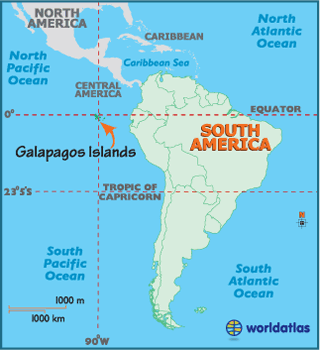1
Question
Short/Long answer type questions:
What is a biogeographic map? Locate Galapagos islands in the world atlas. What was unique about these islands which helped Darwin arrive at significant concepts regarding evolution?
What is a biogeographic map? Locate Galapagos islands in the world atlas. What was unique about these islands which helped Darwin arrive at significant concepts regarding evolution?
Open in App
Solution
Biogeographic map show distribution of species in a map. Organisms and biological communities often vary in a regular fashion along geographic gradients of latitude, elevation, isolation and habitat area.The Galapagos Islands are located in the eastern Pacific Ocean, 973 km (605 mi) off the west coast of South America.
Observation of species especially finches by Darwin led him to propose the theory of speciation by natural selection. A few million years ago, one species of finch migrated to the rocky Galapagos from the mainland of Central or South America. From this one migrant at least 13 species of finches evolved. This process in which one species gives rise to multiple species that exploit different niches is called adaptive radiation. The ecological niches exert the selection pressures that push the populations in various directions. On various islands, finch species have become adapted for different diets: seeds, insects, flowers, the blood of seabirds, and leaves. The ancestral finch was a ground-dwelling, seed-eating finch. After the burst of speciation in the Galapagos, a total of 14 species exist three species of ground-dwelling seed-eaters; three others living on cactuses and eating seeds; one living in trees and eating seeds, and 7 species of tree-dwelling insect-eaters.
The Galapagos Islands are located in the eastern Pacific Ocean, 973 km (605 mi) off the west coast of South America.

Observation of species especially finches by Darwin led him to propose the theory of speciation by natural selection. A few million years ago, one species of finch migrated to the rocky Galapagos from the mainland of Central or South America. From this one migrant at least 13 species of finches evolved. This process in which one species gives rise to multiple species that exploit different niches is called adaptive radiation. The ecological niches exert the selection pressures that push the populations in various directions. On various islands, finch species have become adapted for different diets: seeds, insects, flowers, the blood of seabirds, and leaves. The ancestral finch was a ground-dwelling, seed-eating finch. After the burst of speciation in the Galapagos, a total of 14 species exist three species of ground-dwelling seed-eaters; three others living on cactuses and eating seeds; one living in trees and eating seeds, and 7 species of tree-dwelling insect-eaters.
Suggest Corrections
0
View More
Join BYJU'S Learning Program
Join BYJU'S Learning Program
